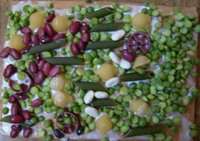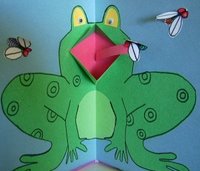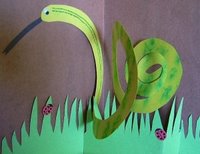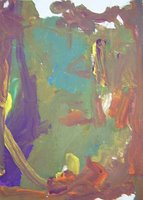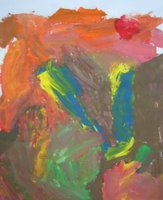 One great open-ended art activity is good, old-fashioned play dough: a perfect example of the value of process vs. end result. Our play dough activity sessions have never produced any "end results," unless you count a plastic bag full of colorful squished up blobs of dough.
One great open-ended art activity is good, old-fashioned play dough: a perfect example of the value of process vs. end result. Our play dough activity sessions have never produced any "end results," unless you count a plastic bag full of colorful squished up blobs of dough.Play dough, unlike clay, is just what it says: a lovely, soft doughlike substance that you simply play with. Clay is hard and takes time to manipulate, giving the impression that it is to be made into something permanent. Oil based clay, although it lasts, is hard for young children to work with, and it smells. Self-hardening, oven-baked, and kiln hardened clays have a purpose - to design or create something that will be completed, painted or glazed, and displayed.
With play dough nothing further is expected, no end-result required. Simply give each child three or four balls of play dough, each a different color. Even the colors are just an added attraction, really. The children are far more interested in the texture of the squishy dough in their hands and between their fingers. They like to manipulate it and to see what they can do with it. I give them a plastic knife for cutting, a cardboard tube for punching holes, and a rolling pin for flattening. Then, I sit quietly at one end of the table and I play with my dough (I get some too). As I work, sometimes they watch what I do, but mostly they come up with their own playful ways of working the dough and using tools. I don't "instruct" them because I want them to explore the material themselves. You can see in these pictures that they are doing just that.
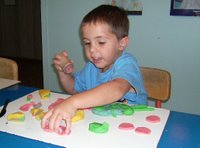 We use a wonderful recipe that takes only a few minutes to make. I make four batches, one each of red (or pinkish), yellow, blue, and green. This dough is not sticky, doesn't smell, and doesn't dry out during use. It will remain soft and flexible after several weeks if stored properly. Here is our recipe:
We use a wonderful recipe that takes only a few minutes to make. I make four batches, one each of red (or pinkish), yellow, blue, and green. This dough is not sticky, doesn't smell, and doesn't dry out during use. It will remain soft and flexible after several weeks if stored properly. Here is our recipe:BETTER-THAN-STORE-BOUGHT PLAY DOUGH
1 cup flour
½ cup salt
1 cup water
1 tablespoon vegetable oil
2 tablespoon cream of tarter
Few drops of food coloring
Mix all ingredients in a pan. Cook over low heat, stirring constantly with a wooden spoon, until mixture pulls away from sides of pan and becomes a large ball. This takes just a minute. Do not over cook. Quickly remove from pan and knead on kitchen counter until smooth. This can be stored in a re-sealable bag in the refrigerator for several months. Note: Double or triple recipe to create several colors.
 If you would like more great childrens' craft recipes, you are invited to get your own copy of our ebook, 75 Craft Recipes For Kids: Crafty Concoctions Your Children Will Love! All proceeds from the sale of this ebook go directly to the Blackfoot Art Center, allowing us continue to offer quality art classes and workshops, as well as step-by-step art activities right here in this weblog.
If you would like more great childrens' craft recipes, you are invited to get your own copy of our ebook, 75 Craft Recipes For Kids: Crafty Concoctions Your Children Will Love! All proceeds from the sale of this ebook go directly to the Blackfoot Art Center, allowing us continue to offer quality art classes and workshops, as well as step-by-step art activities right here in this weblog.
